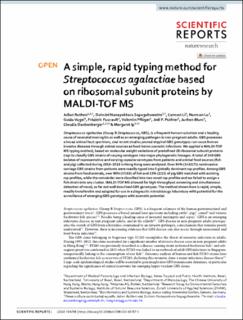Please use this identifier to cite or link to this item:
https://doi.org/10.21256/zhaw-20120| Publication type: | Article in scientific journal |
| Type of review: | Peer review (publication) |
| Title: | A simple, rapid typing method for Streptococcus agalactiae based on ribosomal subunit proteins by MALDI-TOF MS |
| Authors: | Rothen, Julian Sapugahawatte, Dulmini Nanayakkara Li, Carmen Lo, Norman Vogel, Guido Foucault, Frédéric Pflüger, Valentin Pothier, Joël Blom, Jochen Daubenberger, Claudia Ip, Margaret |
| et. al: | No |
| DOI: | 10.1038/s41598-020-65707-5 10.21256/zhaw-20120 |
| Published in: | Scientific Reports |
| Volume(Issue): | 10 |
| Issue: | 8788 |
| Issue Date: | 29-May-2020 |
| Publisher / Ed. Institution: | Nature Publishing Group |
| ISSN: | 2045-2322 |
| Language: | English |
| Subjects: | Medical research; Microbiology |
| Subject (DDC): | 570: Biology |
| Abstract: | Streptococcus agalactiae (Group B Streptococcus, GBS), is a frequent human colonizer and a leading cause of neonatal meningitis as well as an emerging pathogen in non-pregnant adults. GBS possesses a broad animal host spectrum, and recent studies proved atypical GBS genotypes can cause human invasive diseases through animal sources as food-borne zoonotic infections. We applied a MALDI-TOF MS typing method, based on molecular weight variations of predefined 28 ribosomal subunit proteins (rsp) to classify GBS strains of varying serotypes into major phylogenetic lineages. A total of 249 GBS isolates of representative and varying capsular serotypes from patients and animal food sources (fish and pig) collected during 2016-2018 in Hong Kong were analysed. Over 84% (143/171) noninvasive carriage GBS strains from patients were readily typed into 5 globally dominant rsp-profiles. Among GBS strains from food animals, over 90% (57/63) of fish and 13% (2/15) of pig GBS matched with existing rsp-profiles, while the remainder were classified into two novel rsp-profiles and we failed to assign a fish strain into any cluster. MALDI-TOF MS allowed for high-throughput screening and simultaneous detection of novel, so far not well described GBS genotypes. The method shown here is rapid, simple, readily transferable and adapted for use in a diagnostic microbiology laboratory with potential for the surveillance of emerging GBS genotypes with zoonotic potential. |
| URI: | https://digitalcollection.zhaw.ch/handle/11475/20120 |
| Fulltext version: | Published version |
| License (according to publishing contract): | CC BY 4.0: Attribution 4.0 International |
| Departement: | Life Sciences and Facility Management |
| Organisational Unit: | Institute of Natural Resource Sciences (IUNR) |
| Published as part of the ZHAW project: | MALDI-TOF MS for microorganism identification: from pattern recognition towards marker based approaches |
| Appears in collections: | Publikationen Life Sciences und Facility Management |
Files in This Item:
| File | Description | Size | Format | |
|---|---|---|---|---|
| 2020_Rothen_etal_Typing-method-for-Streptococcus-agalactiae-Scientific-Reports.pdf | 1.51 MB | Adobe PDF |  View/Open |
Show full item record
Rothen, J., Sapugahawatte, D. N., Li, C., Lo, N., Vogel, G., Foucault, F., Pflüger, V., Pothier, J., Blom, J., Daubenberger, C., & Ip, M. (2020). A simple, rapid typing method for Streptococcus agalactiae based on ribosomal subunit proteins by MALDI-TOF MS. Scientific Reports, 10(8788). https://doi.org/10.1038/s41598-020-65707-5
Rothen, J. et al. (2020) ‘A simple, rapid typing method for Streptococcus agalactiae based on ribosomal subunit proteins by MALDI-TOF MS’, Scientific Reports, 10(8788). Available at: https://doi.org/10.1038/s41598-020-65707-5.
J. Rothen et al., “A simple, rapid typing method for Streptococcus agalactiae based on ribosomal subunit proteins by MALDI-TOF MS,” Scientific Reports, vol. 10, no. 8788, May 2020, doi: 10.1038/s41598-020-65707-5.
ROTHEN, Julian, Dulmini Nanayakkara SAPUGAHAWATTE, Carmen LI, Norman LO, Guido VOGEL, Frédéric FOUCAULT, Valentin PFLÜGER, Joël POTHIER, Jochen BLOM, Claudia DAUBENBERGER und Margaret IP, 2020. A simple, rapid typing method for Streptococcus agalactiae based on ribosomal subunit proteins by MALDI-TOF MS. Scientific Reports. 29 Mai 2020. Bd. 10, Nr. 8788. DOI 10.1038/s41598-020-65707-5
Rothen, Julian, Dulmini Nanayakkara Sapugahawatte, Carmen Li, Norman Lo, Guido Vogel, Frédéric Foucault, Valentin Pflüger, et al. 2020. “A Simple, Rapid Typing Method for Streptococcus Agalactiae Based on Ribosomal Subunit Proteins by MALDI-TOF MS.” Scientific Reports 10 (8788). https://doi.org/10.1038/s41598-020-65707-5.
Rothen, Julian, et al. “A Simple, Rapid Typing Method for Streptococcus Agalactiae Based on Ribosomal Subunit Proteins by MALDI-TOF MS.” Scientific Reports, vol. 10, no. 8788, May 2020, https://doi.org/10.1038/s41598-020-65707-5.
Items in DSpace are protected by copyright, with all rights reserved, unless otherwise indicated.